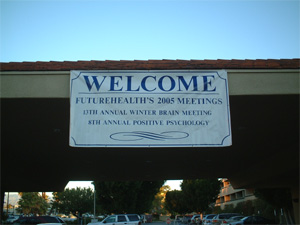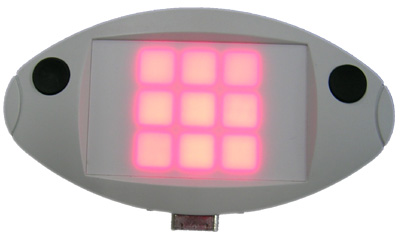Archive for the ‘Conferences’ Category
Thursday, September 15th, 2005
This year’s ISNR Conference was the best attended, and membership is bumping up to 700. The organization is doing well when more than half of the membership shows up for the annual meeting. The exhibit hall reflected the creativity that continues to flourish in this field. One cannot imagine this conference without it. Instrumentation development is moving on from mere utility to concern with style and finish. The Nexus from Mind Media is a particular case in point. The smoothing of displays at user option is a delight. We always had that option on NeuroCybernetics, but it was not easily accessible, so it was hardly used.
Zengar showed up with its four ZenX modes of sequential training by analogy to physical exercise routines, with warm-up and cool-down phases along with the working sessions. Thought Tech has incorporated our training modalities, and we showed the new Infiniti screens for two-channel sum and difference training at our booth. The EEG Info booth also featured the new games for the BioExplorer. Other implementations to follow. Finally, we brought the latest iteration of Sue’s Clinical Decision Tree, which now incorporates an update of lateralized training. Also on exhibit was the new Biofeedback Magazine, with high production values and good editing. The effort deserves to be supported. We need all the publicity to the public that we can get. Every clinician needs this magazine in their waiting room. (more…)
Posted in Conferences | No Comments »
Thursday, July 28th, 2005
We just attended the annual conference on Irlen Syndrome, sponsored by Helen Irlen and her staff, and held here in Long Beach. This was the twentieth anniversary of Helen Irlen’s work, subsequent to her discovery of Scotopic Sensitivity Syndrome in 1983. The conference was a warm and spunky affair. There was still the sense of “us against the world” in the air, but also the swagger of great self-confidence. The remaining adversary in the world at large was nothing more formidable than ignorance itself.
Scotopic Sensitivity Syndrome refers to the condition in which individuals find their vision compromised, particularly in reading, under bright light or simply full spectrum light conditions. This may present a particular problem with high spatial frequencies in the visual field, such as steps on escalators, hotel carpets, or as encountered in written material. Words may move; lines may flow into each other; the spaces between words on the page may merge into large-scale gestalts (rivulets down the page), etc. The condition is easily screened for, and the straight-forward and categorical remedy is to limit the spectral input to the eye in some fashion so that the person can see normally. This can be most inexpensively done with colored overlays, and more assuredly with properly fitted colored-lens eyewear. In the absence of a proper diagnosis, people nevertheless may find their way to a remedy, such as preferring a darkened room for reading, favoring certain colors of sunglasses, and avoiding bright scenes as much as possible. (more…)
Posted in Clinical Methods, Conferences | 1 Comment »
Thursday, June 30th, 2005
I decided to attend the annual conference of the International Society for the Study of Subtle Energy and Energy Medicine, meeting this year in Colorado Springs, in order to catch up with where this organization is presently, and while the principals that gave life to the organization originally (Elmer Green and the Menninger group) are still around.
I went with mixed feelings. First of all, we’ve got quite enough controversies on our hands without going out of our way to find new conundrums, and yet new ways to discomfit the medical mainstream. Also, I feared a beguiling proselytizing rush from the right-brain people. On the other hand, this organization is home to people even more fearless, people who are willing to do quite bizarre experiments to prove their theories. If one needs to recharge one’s batteries with dollops of courage, this is the place to go.
The initial talk I heard was not reassuring. It was by Elizabeth Rauscher, who started out life as a physicist. Why is it, incidentally, that so many of these researchers started out as physicists? One reason may be that if these bizarre things were said by anyone other than a physicist, less attention might be paid. Another may be that physicists are more fearless when it comes to the exotic frontier. We’ve had a revolution or two or three under our belt already, and we’re getting used to it. In any event, some outlandish phenomenology from quantum mechanics punctuates the discussion from time to time, which then entitles the speaker to make great leaps into the unknown. The connection is often lost. (more…)
Posted in Conferences | No Comments »
Thursday, May 12th, 2005
The first ROSHI Conference was held in Pasadena this past weekend. It was a chummy affair in a revitalizing Old Town locale, with a lively group of ROSHI enthusiasts in attendance. Stephen Overcash gave the first formal presentation, on an integrated approach to the use of ROSHI. He goes back to the early days of the field with Tom Budzynski and Chuck Stroebel, so his ties to traditional peripheral biofeedback remain firm. He combines ROSHI with both CES (Alpha-Stim) and TENS. Interestingly he finds no contamination of the EEG signal from the CES unit, which he operates in the low frequency mode. With the pROSHI there should be no issue at all, since it is not EEG-dependent.
Tom Allen spoke later in the conference to the same theme, saying that he personally would never just put an EEG electrode on a person, but rather always insists on some of the peripheral measures as well. Overcash finds the ROSHI helpful for post-anesthesia malaise and cognitive fog. And he has used it with soccer players who have done too many headers. He recommends Tom Budzynski’s audio CDs for homework. (more…)
Posted in Conferences | No Comments »
Thursday, February 10th, 2005
 This was the thirteenth Winter Brain Conference, the first in some time without its own special T-shirt. The crowd was somewhat smaller this year than in the past couple of years. This tends to happen when the location stays the same for too many years, although the Hilton was certainly a good host, and the local weather gods were favorably disposed as well. The exhibit area was noisy and boisterous again. The conference was significantly “privatized” this year, with more training seminars booked before and after the Conference. This took away some of the energy from the conference itself, but it was nevertheless another opportunity to mix it up with the other people who are thankfully pushing the boundaries of this field. In that regard, this conference remains unique for its accepting and inclusive ambience. This was the thirteenth Winter Brain Conference, the first in some time without its own special T-shirt. The crowd was somewhat smaller this year than in the past couple of years. This tends to happen when the location stays the same for too many years, although the Hilton was certainly a good host, and the local weather gods were favorably disposed as well. The exhibit area was noisy and boisterous again. The conference was significantly “privatized” this year, with more training seminars booked before and after the Conference. This took away some of the energy from the conference itself, but it was nevertheless another opportunity to mix it up with the other people who are thankfully pushing the boundaries of this field. In that regard, this conference remains unique for its accepting and inclusive ambience.
The Winter Brain Conference continues with its traditional quirks: A Foundations Course that goes from 8 AM until 10 PM; plenary sessions that start before 8 in the morning; a schedule that drags out for five days; and a prohibitive admission fee that must discourage the casual attendee. The value of the conference is surely equivalent to that of a training course, but people may not know that when they have to commit their funds and time; many others don’t start out with that level of commitment to the field. The conference again paired the Winter Brain Conference with StoryCon, so both sides of the brain were being engaged. There was unfortunately no communal acknowledgement of the death of Marjorie Toomim. So Hershel had to handle this himself. And the after-dinner speaker this time was a comedian who tried to engage us with irrelevancies. What a come-down after we had been spoiled the last couple of years with Swami Beyondananda, and after the national tragedy of our recent election. (more…)
Posted in Conferences | No Comments »
Thursday, February 3rd, 2005
We are once again at the threshold of the Winter Brain Conference. Preliminary conferences are already going on. This year will mark the entry of EEG Support into the hardware business. With the help of a few gnomes of Zurich we have developed a QIKtest device that allows us to run a variety of choice reaction time tests like the CPTs we are used to. Just working through the development process has been liberating to our thinking. There has been controversy among users about just how fast progress in TOVA terms can be made with various techniques. We’ve been reluctant to subject people to a lot of such tests because they are such an imposition on people. Now we have a choice.
 The QIKtest The QIKtest
The new device has nine LED fields in a 3×3 array, and a left and right button for responding. Auditory challenges are available as well. Any combination of LEDs can be used to represent the “go” or “no-go” condition. The tests can be down-loaded through a serial connection from the clinician’s computer to the device. The device stores the test results internally, until they are uploaded to the computer, where the results are then displayed. The data is then uploadable to the EEG Expert website for progress tracking over sessions. (more…)
Posted in Conferences | No Comments »
|
|
Subscribe to Email Newsletter
The EEG Info Newsletter circulates via email at least once a month. A variety of topics related to the Neurofeedback / EEG Biofeedback field are covered in over 200 articles.
|

 This was the thirteenth Winter Brain Conference, the first in some time without its own special T-shirt. The crowd was somewhat smaller this year than in the past couple of years. This tends to happen when the location stays the same for too many years, although the Hilton was certainly a good host, and the local weather gods were favorably disposed as well. The exhibit area was noisy and boisterous again. The conference was significantly “privatized” this year, with more training seminars booked before and after the Conference. This took away some of the energy from the conference itself, but it was nevertheless another opportunity to mix it up with the other people who are thankfully pushing the boundaries of this field. In that regard, this conference remains unique for its accepting and inclusive ambience.
This was the thirteenth Winter Brain Conference, the first in some time without its own special T-shirt. The crowd was somewhat smaller this year than in the past couple of years. This tends to happen when the location stays the same for too many years, although the Hilton was certainly a good host, and the local weather gods were favorably disposed as well. The exhibit area was noisy and boisterous again. The conference was significantly “privatized” this year, with more training seminars booked before and after the Conference. This took away some of the energy from the conference itself, but it was nevertheless another opportunity to mix it up with the other people who are thankfully pushing the boundaries of this field. In that regard, this conference remains unique for its accepting and inclusive ambience. The QIKtest
The QIKtest